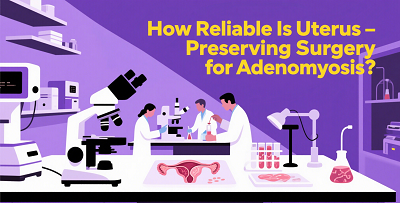How Reliable Is Uterus-Preserving Surgery for Adenomyosis?
Adenomyosis is a common gynecological disorder characterized by the invasion of endometrial tissue into the uterine muscle layer, leading to symptoms such as dysmenorrhea (painful periods), heavy menstrual bleeding, and infertility, which significantly impact women's quality of life. Generally, patients can choose traditional treatment options include medication, hormonal therapy, and hysterectomy (complete removal of the uterus).

However, if you want to preserve uterus, uterus-preserving surgery (also known as adenomyomectomy) has become an important alternative. But is this procedure truly reliable? Let's explore this in detail.
What Is Uterus-Preserving Surgery
Uterus-preserving surgery, or adenomyomectomy, is a surgical procedure designed to remove diseased uterine muscle tissue while preserving the typical structure and function of the uterus. Unlike a hysterectomy, this approach prioritizes maintaining fertility and uterine physiological function, making it particularly suitable for women who wish to conceive or retain their uterus.
It is normal to feel apprehensive about this surgery if you are unfamiliar with it. Read on, and you may gain greater confidence in this surgical option.
Advantages of Uterus-Preserving Surgery
1. Preservation of the Uterus and Fertility: The surgery precisely removes lesions while preserving the uterus, making it ideal for women with future pregnancy plans.
2. Low Recurrence Rate: Compared to other treatments like ablation or uterine artery embolization, adenomyomectomy has a relatively lower recurrence rate.
3. Symptom Relief: Post-surgery, patients typically experience significant improvements in dysmenorrhea and reduced menstrual bleeding, enhancing their quality of life.
4. Avoidance of Hormonal Side Effects: Since the procedure does not affect ovarian function, it eliminates the long-term side effects associated with hormonal therapies, such as osteoporosis and hot flashes.
In the past, uterus-preserving surgery for adenomyosis carried high risks, including excessive bleeding, poor wound healing, and uterine rupture if lesions were not completely removed. However, modern surgical advancements have improved safety, allowing for thorough lesion removal while minimizing complications. The procedure not only excises all pathological tissue but also preserves endocrine and reproductive functions—key advantages of conservative surgical treatment for adenomyosis.
While the outcomes are promising, many patients wonder: Does adenomyosis recur after surgery? Let's examine this concern.
Risk of Recurrence After Surgery
Although recurrence is possible after adenomyomectomy, patients can reduce this risk through regular follow-ups, proper hygiene, and lifestyle adjustments.
Adenomyosis is an estrogen-dependent disease, meaning its progression is closely linked to estrogen and progesterone levels. Since adenomyotic lesions are often diffuse (widely distributed within the uterine wall), completely removing all affected tissue can be challenging. Even after successful surgery, residual microscopic lesions may remain and potentially regrow under continued estrogen stimulation.
The primary goal of uterus-preserving surgery is to alleviate symptoms while retaining the uterus. However, it does not eliminate the underlying pathology—the abnormal growth of endometrial glands and stroma within the uterine muscle. Therefore, postoperative management, including hormonal regulation and monitoring, is crucial to prevent recurrence.
Other factors influencing recurrence risk include:
Age: Younger patients with higher estrogen levels may face a greater risk.
Reproductive history: Women who have not completed childbearing may have different recurrence patterns.
Postoperative care: Poor adherence to follow-up or inadequate monitoring can delay detection of recurrent lesions.
Comorbidities: Other gynecological conditions (e.g., endometriosis) may affect outcomes.
Postoperative Preventive Measures
To minimize recurrence, patients should:
1. Attend regular check-ups to monitor for disease recurrence.
2. Maintain proper hygiene (especially genital and sexual) to prevent infections.
3. Adopt a healthy lifestyle, including stress management and avoiding excessive physical strain.
Traditional Chinese Medicine: The Role of Fuyan Pill in Managing Adenomyosis
In addition to surgery and hormone therapy, Traditional Chinese Medicine (TCM) offers complementary approaches for managing adenomyosis, especially in postoperative care or for patients who wish to avoid surgery altogether. Among these, the Fuyan Pill has shown promising results in clinical practice.
Fuyan Pill is a patented Chinese herbal formula known for its anti-inflammatory, pain-relieving, and blood-circulation-promoting properties. It works by clearing heat, detoxifying the body, improving blood flow, and eliminating stasis—core principles in TCM when treating gynecological inflammation.
Benefits of Fuyan Pill for Adenomyosis Patients:
Symptom Relief: Helps reduce dysmenorrhea and pelvic discomfort.
Hormonal Balance: Regulates endocrine function naturally without synthetic hormones.
Prevention of Recurrence: By improving circulation and addressing the root imbalances, it supports long-term stability after surgery.
Non-invasive Option: Particularly helpful for patients unable or unwilling to undergo surgery.
While Fuyan Pill is not a replacement for surgery in severe cases, it can be an effective adjunct or alternative for patients with mild to moderate adenomyosis or those focusing on postoperative recovery and symptom control.
In summary, uterus-preserving surgery is a reliable treatment for adenomyosis, particularly for women with localized lesions, fertility desires, or a strong preference for uterine preservation. Its benefits include effective symptom relief, maintained fertility, and improved quality of life. However, surgical success depends on factors like lesion extent, surgical technique, and postoperative care; recurrence remains a possibility.
Therefore, patients should consult a specialized gynecologist to determine the most suitable treatment plan and commit to long-term postoperative management for optimal results.
If you are struggling with adenomyosis, seek professional medical advice early to develop a personalized treatment strategy and reclaim a healthier life!
The Mystery of Lower Abdominal Pain: Could Adenomyosis Be the Culprit?
previous pageCan You Still Get Pregnant with Adenomyosis? 4 Truths Every Woman Should Know
next pageTestimonials
- Adenomyosis with Ureaplasma Urealyticum Cured by Fuyan Pill
- Tubal blockage with hydrosalpinx can be cured by TCM shortly
- Fuyan Pill Helps A woman with Adenomyosis Get Pregnant
- A Woman with Hydrosalpinx Is Cured with Fuyan pill
- Pelvic Inflammatory Disease Testimonials
- Irregular Vaginal Bleeding and Endometrial Thickening Cured by Fuyan Pill
- Pruritus Vulvae and Frequent Urination: Mycoplasma Infection Cured after 2 Courses



